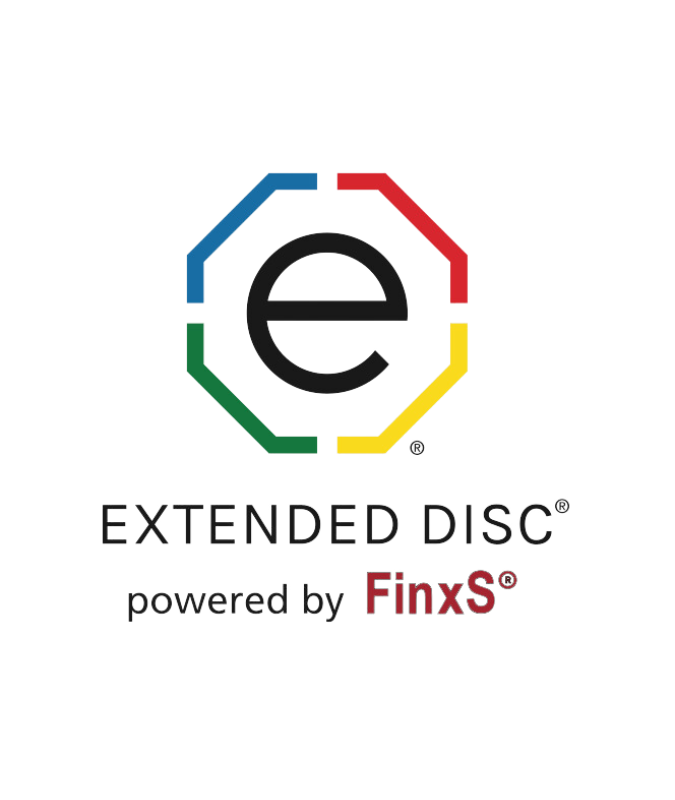
Extended DISC® Resources
The Extended DISC® assessments are the perfect tools to take individual, team, and organizational performance to the next level.
This Individual Assessment will provide you with the map to more successful interactions with others.
Understanding your DISC-style can help you bring the best version of yourself to work every day… and foster a harmonious and productive work environment.
By taking the time to learn about DISC styles and how they work together, you’ll be on the path to building effective working relationships.
Why Extended DISC®?
Understanding human behavior is paramount when assembling and leading a cohesive team. One powerful tool for decoding behavior is the DISC assessment, which categorizes individuals into four primary behavioral styles: Dominance, Influence, Steadiness, and Conscientiousness.
Each style brings unique strengths and communication preferences to the table. Dominant individuals are assertive and results-oriented, while Influencers excel in networking and collaboration. Steadiness brings stability and reliability, whereas Conscientiousness emphasizes accuracy and attention to detail.
While the diversity of a team can be a huge asset, it can also be a huge headache if we can’t effectively communicate with each other. A key to building a successful team lies in understanding the different styles and how they communicate with one another.
Navigating different DISC styles is not easy. By taking the time to learn about DISC styles and how they work together, you’ll be on the path to building effective working relationships.
Extended DISC® assessments are the perfect tools to take individual, team, and organizational performance to the next level.
“Everything that irritates us about others can lead us to an understanding of ourselves.”
Introduction to Extended DISC
Extended DISC® assessments are the perfect tools to take individual, team and organizational performance to the next level.
Each one of us falls into one or more of the 4 DISC behavioural styles.
Five DISC Myths
Diversity in the workplace is invaluable!
With more perspectives and work styles, a team and organization gains new ideas and better ways to serve customers.
But, navigating different DISC styles is not easy. By taking the time to learn about DISC styles and how they work together, we’ll be on the path to building effective working relationships.
DISC Styles in an Elevator
Work environments are unique and dynamic. The larger the company, the more DISC styles you’ll encounter.
A key to building a successful and harmonious workplace lies in understanding the different styles and how they communicate with one another.
D-style = Active and Task-oriented (red)
Talks about: Goals, oneself, hard values ($, revenue, profits) results, change.
D-Style Training Video
In this video you will learn some attributes and behaviors of D-Styles. Key points mentioned in the video include how D-Styles communicate, decide, act under pressure, and succeed.
D-Style Modifications
In this video, we’re going to explore the D-style… Dominance… to give you an understanding of how this style is likely to respond in certain situations.
Then, we’ll look at how through awareness and small modifications, D’s can transform a negative situation into a successful outcome.
How to identify D-styles
Motto: I did it my way.
Focus: Actively controls tasks and things.
Under pressure: Lack of concern. This refers to D-styles’ tendency to overlook how their actions and behaviours affect others.
Fear: Loss of control. This refers to D-styles’ desire to be in charge. They do not want to give up control.
Favourite question: What? (What is the bottom line? What is in it for me?)
Communication Style: Often to only one direction – he/she talks and expects others to listen. Expresses own opinions as facts that need no further discussion. May be blunt and challenges others. Interrupts others often
I-style = Active and People-oriented (yellow)
Talks about: People, team-spirit, good things, future, oneself.
I-Style Training Video
In this video you will learn some attributes and behaviors of I-Styles. Key points mentioned in the video include how I-Styles communicate, decide, act under pressure, and succeed.
I-Style Modificiations
This video explores the I…Influence… DISC style. We’re going to see how the I likely will communicate.
You’ll see what works…what doesn’t…and how small modifications can help the I be more effective and successful with their communication
How to identify I-styles
Motto: “I am a nice person. Everyone should like me.”
Focus: Actively involved with people and emotions.
Under pressure: Disorganized. I-styles have a tendency to focus so much on people that they may overlook details and tasks.
Fear: Social rejection. I-styles have a strong desire to be liked by others.
Favourite question: Who? (Who is going to be at the meeting? Who else is using this?)
Communication Style: Selling and inspiring. Talks a lot, but not about details. Avoids unpleasant subjects. Good at providing positive, constructive feedback. Not always direct
S-style = Reserved and People-oriented (green)
Talks about: Agreements, principles, past, proofs, one’s team.
S-Style Training Video
In this video you will learn some attributes and behaviors of S-Styles. Key points mentioned in the video include how S-Styles communicate, decide, act under pressure, and succeed.
S-Style Modifications
This video explores the S…Steadiness…DISC style. You’ll learn how the S interacts with their colleagues and their strengths and development areas.
You’ll also see how small modifications can help S communicate better and become an invaluable team asset.
How to identify S-styles
Motto: If it’s not broken, let’s not fix it.
Focus: Involved with familiar people.
Under pressure: Too willing. S-styles’ have a tendency to be accommodating and polite. Often they say “yes” too easily.
Fear: Loss of stability. S-styles have a desire to have a stable and secure environment. Change can be challenging for S-styles.
Favourite Question: How? (How are we going to do this? How does this impact us?)
Communication Style:
Often only to one direction. They listen. Answers when asked. Talks calmly. Creates trust. Talks about topics they master. Better in one-to-one situations. Good instructor
C-style = Reserved and Task-oriented (blue)
Talks about: Facts, analyses, details, rules, instructions
C-Style Training Video
In this video you will learn some attributes and behaviors of C-Styles. Key points mentioned in the video include how C-Styles communicate, decide, act under pressure, and succeed.
C-Style Modificiations
This video will explore C…Conscientiousness…DISC style. You’ll learn how the C interacts with their colleagues and their unique strengths and development areas.
You’ll also see how small modifications can improve C’s communication and influence with their peers.
How to identify C-styles
Motto: “If we do not have time to do it right, do we have time to do it over again?” As a result, C-styles are good in ensuring quality control.
Focus: Analyzes tasks and things.
Under pressure: Overly critical. C-styles have a tendency to be so focused on the details that they often
find mistakes and errors. The other styles may find C-styles too critical.
Fear: – Criticism of work. C-styles want to be correct and to produce high-quality work. They do not want to make mistakes.
Favourite question: Why? (Why does is work this way? Why should we do it?)
Communication Style: Better in written communication. Doesn’t express disagreeing views. Includes a lot of facts and details. May miss the big picture. Doesn’t talk about opinions or abstract matters. Extremely diplomatic
Ready to expand Extended DISC in your organization?
The Extended DISC® assessments are the perfect tools to take individual, team, and organizational performance to the next level.
Take the first step by getting in touch with us.


